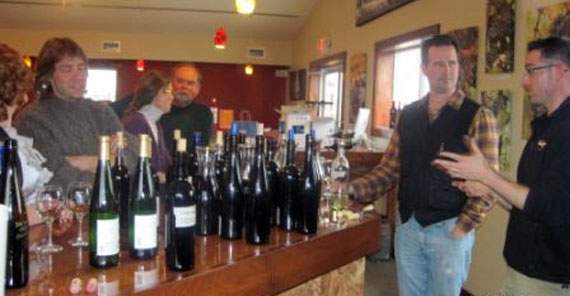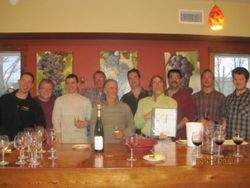By Evan Dawson, Finger Lakes Editor
Some of the 86 acres of vines at Sawmill Creek Vineyards rise so steeply that a machine harvester can not safely venture between the rows. The site on the southeast side of Seneca Lake provides fruit for nearly 30 wineries every year, and its combination of slope, location and vineyard management has earned Sawmill Creek a strong reputation.
Recently a fascinating question arose in the mind of Dave Whiting, winemaker at Red Newt Cellars: How would the wines made from Sawmill Creek in 2010 show, side-by-side, in a tasting featuring many of the producers who use this fruit?
Surely there would be some similarities. The hand of man can not fully obscure nature, nor would these winemakers wish to do so. But it's also true that they employ different methods in making wine from this same fruit. So a group of winemakers convened at the Hector Wine Company for a comparative event.
2010: "A spectacular growing season"
The length and warmth of the 2010 growing season produced tremendous potential in red wines in particular, but seeking out nuance and difference was a challenge for the winemakers.
"The 2010 had great quality across the board, with concentration, color and varietal strength," said Tim Moore, winemaker at Inspire Moore Winery on Canandaigua Lake.
At Rooster Hill on Keuka Lake, winemaker Barry Tortolon finds 2010 to offer a spectacular vintage without becoming overripe. "I did not have any over-the-top sugar levels but overall ripeness was the best I have seen in a long, long time," Tortolon said. "Even at at this early stage in their lives the reds are already showing good."
"We are going to see some phenomenal reds from the 2010 vintage," said Phil Arras, assistant winemaker at Damiani Wine Cellars. He pointed to the tannic structure and clear, powerful fruit already present in the wines.
But Arras added, "At this point in the life of a red, they are in a very reductive and closed down state, and it's hard to pick up on a lot of subtle differences. To say that some had brighter or bigger fruit than others would be a bit misleading at this point, since many are in a very closed and tight state."
There was, however, one clear difference that was impossible to miss.
Oak stands out in 2010 reds
"For the reds the most obvious differences seemed to be the use and type of oak," Arras said, echoing a common sentiment among the winemakers who attended.
"I must say that winemaking methodology has a big impression on outcome, especially on red wine production," Moore explained.
Finger Lakes winemakers use a wide range of oak, from new to neutral or old, and from American to Hungarian to the most expensive, French. Some winemakers described the sweet or smoky notes of oak's influence on many of the reds. All expressed optimism that with time, those components will weave together with the fruit to offer bold, balanced wines.
"I'd really love to do the same tasting again in about three or four years, when the 2010ss have been in the bottle for a few years and we can really see the differences in the finished products," Arras said. Indeed, the group made plans to hold this kind of tasting on a regular basis to evaluate the differences.
Going a step farther, Moore explained, "The group talked about making some universal lots next year to evaluate the terroir of Sawmill Creek Vineyard."
Optimism over white wines, too
Tortolon praised the chardonnay and sauvignon blanc from Sawmill Creek, while others are already eager to see the development of riesling. Tim Moore announced plans to create Inspire Moore's first-ever Reserve wines with the 2010 vintage.
Tina Hazlitt, Sawmill Creek's office manager who helped coordinate the event, said there was a lot to learn for the growers, too.
"We feel more connected to the wines and winemakers after events like this," she said. "It's so interesting to see how each brings their own approach. And these are relatively young winemakers who obviously want to learn as much as they can. We think they're doing wonderful things with Sawmill Creek fruit."
Hazlitt also said that Sawmill Creek's goal is to eventually work with only about a dozen wine producers in the region, which would further strengthen the growers' connection to the wines. She envisions signs on each block of vines, explaining which Finger Lakes winery will use the fruit. "That would make us proud," she said.
There will be a lot more to learn when this group reconvenes in a year, or three years, or five years. But this first event shows the spirit of exploration and inquiry that any wine region needs to become truly successful.


